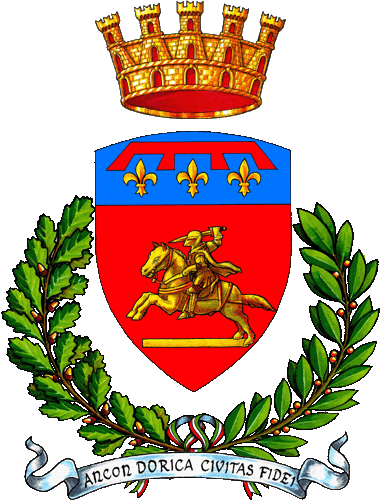|
Saint Cyriacus Cathedral
La Cattedrale di San Ciriaco
City of Ancona
Le Marche
Italy
If it is true that every place has a
soul that represents its origins and summarises its history, then the soul
of the city of Ancona lies where the Cathedral of San Ciriaco stands.
When, in the 4th
century BC, the Dorians arrived in Ancona and named it Ankon
because of its unique elbow shape which stretches out along the clean
waters of the Adriatic, they chose the summit of Colle Guasco, which
calmly overlooks the bay, as the symbolic centre of the civic framework:
they built a temple dedicated to Venus Euplea (so that it was a place of
worship and an indication of the shore for ancient navigators) and
around it they deployed seats of power (the agora, the forum, the
theatre) surrounded by walls made of large sandstone blocks.
The first building to be built
in the 5th century BC was the early Christian basilica
dedicated to Saint Lorenzo, which began new life in the year 1000 AD
when the bodies of Saint Cyriacus and Saint Marcellino were moved there
and it became a Cathedral. The lengthy construction work on the new
building continued until 1200 and during this period the Cathedral
breathed the cultural vitality of the city and absorbed its physical
features, epitomising them in an astonishing fusion of Romanesque,
Byzantine and Gothic styles, which make up one of the most interesting
examples of Romanesque architecture in Marche. The façade is a
tripartite cusp and is preceded by a wide staircase whose sides are
lined with imposing, red marble lions that remain eternally watchful
over the sacredness of the place. Inside, one is immediately fascinated
by the vastness of the spaces and the vertical development of the vaults
that culminate in a Byzantine-style cupola with Gothic influences, which
is deftly erected on the four pillars and bestows a form of austere and
exquisite harmony upon the entire construction.
The cathedral is named after
Cyriacus; a bishop saint of Armenian origin who became a martyr in
Ancona in the 2nd century AD and was elevated to the honour
of patron saint of the city, having been martyred with the pouring of
molten lead down his throat. Another important object of worship in the
faith of Ancona is kept here: the miraculous painting of the Virgin
of all Saints. According to tradition, the painting was donated to
the Bishop of Ancona by a wealthy, Veronese merchant around 1620 and by
the second half of the following century was already an object of strong
veneration by part of Ancona’s population. In 1796, whilst the invasion
of Marche by the Napoleon Bonaparte’s forces was taking place, many
testified that the Virgin moved her gaze. On hearing these rumours,
Napoleon himself wanted to see the painting, but he was so disturbed
that he ordered the restitution of the gleaning carried out by his
soldiers in the cathedral and the churches in Ancona.
The recent wounds inflicted upon
the cathedral by Anglo–American aerial bombings in 1943 and by the
earthquake in 1972 have been healed with an extensive restoration that
today – under the protection of a sheet of glass on the aisle floor –
allows one to see the remains of the first temple dedicated to Venus
Euplea.
The cathedral, witness to the
birth and development of the Dorian city, has forever embraced the city
and the sea with its portal, and has watched over the landing place of
travellers in the protected port below.
Come to heart of ancient Ankon,
not only to discover this fascinating example of fusion between
Romanesque, Gothic and Byzantine art, but also to see the magic of one
of the most beautiful sunsets on the Adriatic coast.
Special Thanks to:
Municipality of Ancona

Copyright Liberation Ventures Ltd.
|